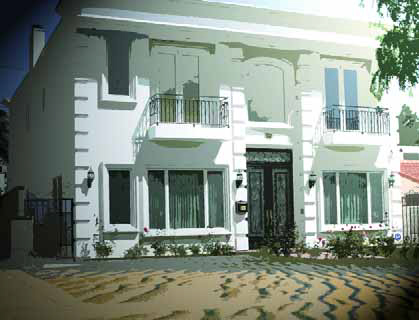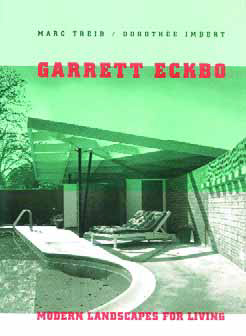architecture
Throughout ancient times, water was central to the thinking of Arab, Persian, Moorish, Moghul and Turkish architects and designers, with largely anonymous representatives of each civilization preparing elaborate spaces with fountains, reflecting pools and other watershapes at their hearts. In the past, these societies' greatest architectural works almost invariably featured elaborate watershapes that bespoke their technical skills as well as a general love affair with the beauty, luxury and necessity of water. With new developments burgeoning across much of the Middle East these days, fountains and watershapes of all varieties are once again playing important roles in design as
Recently, much has been written and discussed in our local Los Angeles media - newspapers, magazines, television - about an influx of architectural styles to our area that "just don't fit in" and are generally thought of as being a blight on our collective landscape. This isn't anything new, of course. I recall similar dustups in the 1970s and '80s when the stylistic serenity of old, established neighborhoods was being disrupted by the insertion
Recently, much has been written and discussed in our local Los Angeles media - newspapers, magazines, television - about an influx of architectural styles to our area that "just don't fit in" and are generally thought of as being a blight on our collective landscape. This isn't anything new, of course. I recall similar dustups in the 1970s and '80s when the stylistic serenity of old, established neighborhoods was being disrupted by the insertion
As watershape environments become increasingly integrated with homes and overall exterior spaces, increasing numbers of our clients are asking us for associated structures - everything from outdoor kitchens and dining areas to arbors, cabanas and pool houses. In my case, just about every single design I tackle includes one or more of these features. What this means is that we watershapers are effectively being drawn into the world of architecture. While we may not ultimately design or build these structures, at the very least we need to be familiar enough with their ins and outs that we can talk about them intelligently in the context of a given project. I've picked up a lot of basic knowledge through experience and close observation, but I recently decided to seek out a formal reference that would help me give definitive answers to a wide range of these questions, some as simple as inquiries about how much
As watershape environments become increasingly integrated with homes and overall exterior spaces, increasing numbers of our clients are asking us for associated structures - everything from outdoor kitchens and dining areas to arbors, cabanas and pool houses. In my case, just about every single design I tackle includes one or more of these features. What this means is that we watershapers are effectively being drawn into the world of architecture. While we may not ultimately design or build these structures, at the very least we need to be familiar enough with their ins and outs that we can talk about them intelligently in the context of a given project. I've picked up a lot of basic knowledge through experience and close observation, but I recently decided to seek out a formal reference that would help me give definitive answers to a wide range of these questions, some as simple as inquiries about how much
By now, we all know that pools and certain other watershape forms have been around since ancient times. It's my strong suspicion, however, that most of us who design and build backyard swimming pools today would fail a pop quiz about those who pioneered the 20th-century genre of pool design. I was among you in not knowing, for instance, about the seminal role played in this arena by a man named Garrett Eckbo - this despite the fact that he's one of the icons of landscape architecture. As a founding member of (and the "E" in) EDAW, Eckbo was responsible for some of the grandest public spaces in the United States. He was also, it seems, an innovator in residential garden and pool design who put his stamp on just about every basic pool form we use today. I picked up this knowledge from a book by Marc Treib and Dorothy Imbert called Garrett Eckbo: Modern Landscapes for Living (University of California Press, 1997). The 190-page volume covers the major career phases of a California-based designer and longtime professor who
By now, we all know that pools and certain other watershape forms have been around since ancient times. It's my strong suspicion, however, that most of us who design and build backyard swimming pools today would fail a pop quiz about those who pioneered the 20th-century genre of pool design. I was among you in not knowing, for instance, about the seminal role played in this arena by a man named Garrett Eckbo - this despite the fact that he's one of the icons of landscape architecture. As a founding member of (and the "E" in) EDAW, Eckbo was responsible for some of the grandest public spaces in the United States. He was also, it seems, an innovator in residential garden and pool design who put his stamp on just about every basic pool form we use today. I picked up this knowledge from a book by Marc Treib and Dorothy Imbert called Garrett Eckbo: Modern Landscapes for Living (University of California Press, 1997). The 190-page volume covers the major career phases of a California-based designer and longtime professor who
Successful design is, I think, most readily achieved by linking a landscape to the architecture it accompanies. During my years as a landscape designer, however, I've seen far too many places where the landscape was apparently designed in a vacuum, displaying little to no connection to the home or any other structures on site. To the contrary, our job as landshapers is to
All projects come to an end, of course, but there are times when the inevitable takes its own, sweet time. The project featured here, for example, took more than six years from the time I first met the clients until we wrapped things up. Unlike some projects that take a long time because of ongoing problems, change orders and difficult challenges, this one was very much a labor of love from start to finish. Sure, there were some tough spots, but for the most part, this was one of those jobs that we watershapers and landscape professionals can only hope will come along from time to time - projects we don't mind extending through a period of years. This one had everything going for it, starting with great clients who had the resources to do something special as well as playful, fun-loving personalities that made the process exciting and rewarding. Then there was the property: an acre of ocean-view hillside in Brentwood, Calif., with mature trees and a big, Cape Cod-style house that was going through extensive remodeling during the time we were involved with the landscape. The clients wanted something that was elegant but playful, with formal lines and structures but a light overall touch. They insisted on beautiful materials, were heavily involved in every decision and, ultimately, had our firm, New Leaf Landscape of Agoura Hills, Calif., work with
In my years as a practicing landscape architect, I've found that designers love in particular to borrow elements from the Spanish Colonial style of architecture. In fact, it has become one of the most important and influential of all architectural forms. This archetypal architecture flourished between the 16th and early-19th centuries in the New World and is based upon historical models established in



















